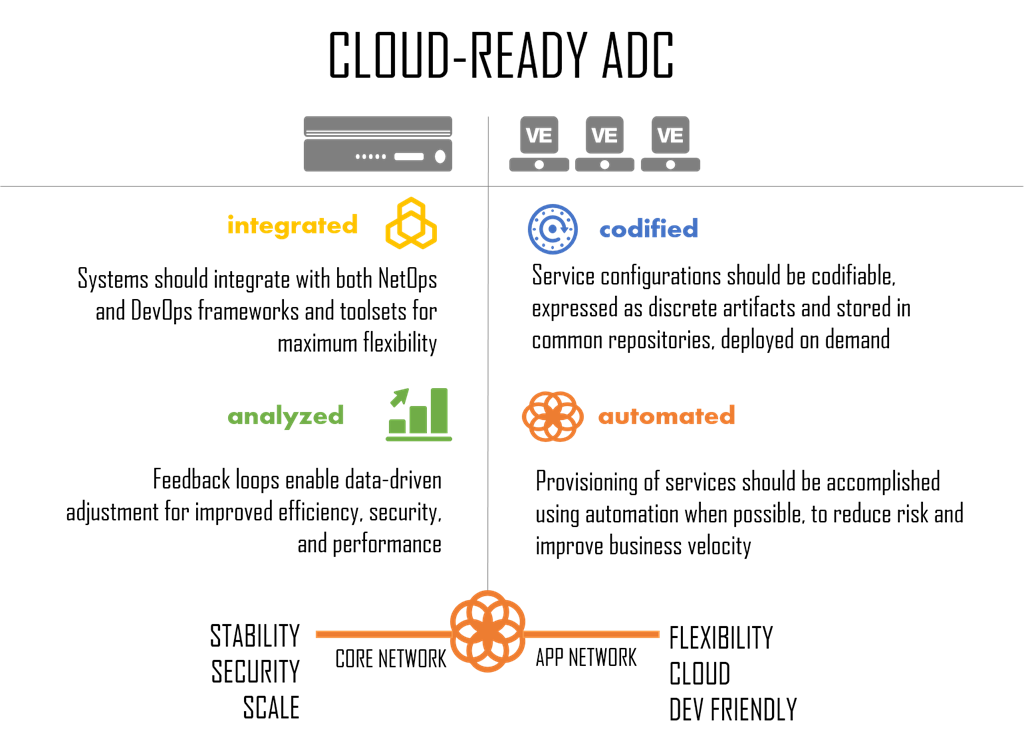El ADC listo para la nube: ¿Qué ventajas ofrece NetOps?

Un controlador de entrega de aplicación (ADC) listo para la nube no es un ADC tradicional. Disponible para implementación en hardware personalizado o COTS, es una solución de software escalable que satisface la necesidad de una entrega e implementación de aplicaciones rápidas, seguras y disponibles. Un ADC preparado para la nube permite un enfoque moderno de dos niveles para las arquitecturas de centros de datos que combinan la estabilidad, la seguridad y la escala tradicionales con funciones programáticas modernas, flexibles, compatibles con la nube y DevOps.
¿Qué beneficios aporta NetOps?
Las operaciones de red, o NetOps por sus siglas en inglés, se enfrentan cada vez más a la tarea de abordar una mayor complejidad operativa con presupuestos estancados. Si bien se está produciendo un cambio de poder que está trasladando algunos servicios de infraestructura, como el equilibrio de carga, al ámbito de las operaciones tradicionales, la mayor adopción de la nube pública y la creciente demanda de nube privada siguen presionando a NetOps para que se mueva más rápido e implemente con mayor frecuencia. Manteniéndose dentro del presupuesto.
La automatización y la orquestación, a través de la adopción de plataformas como OpenStack , Cisco ACI y VMware, son una de las formas en que NetOps está enfrentando este desafío . Al adoptar marcos que promueven la “infraestructura como código” al permitir implementaciones basadas en plantillas, NetOps puede proporcionar un entorno más “de autoservicio” a través del cual se pueden implementar servicios de aplicación y redes tradicionales. Esto genera menores costos operativos, porque los ingenieros ya no necesitan aprovisionar, configurar e implementar servicios manualmente, además de una mayor velocidad. Permite que NetOps escale de manera eficiente para satisfacer la demanda y reduce la fricción que ha existido durante mucho tiempo y que causa demoras en la implementación de aplicaciones.
Un ADC preparado para la nube logra esto mediante la programabilidad . Llamémoslo “infraestructura definida por software” o “infraestructura como código”. Cualquiera sea la nomenclatura que adopte, la realidad es que el “software” es el futuro del centro de datos no por su factor de forma (después de todo, todavía necesita hardware), sino por la flexibilidad que ofrece la capacidad de aprovechar el código para implementar la lógica, ya sea para enrutamiento o seguridad, escala o velocidad.
Es por eso que un ADC preparado para la nube admite configuraciones basadas en plantillas e implementaciones habilitadas para API a través de los marcos que las empresas utilizan hoy en día para lograr una mayor escala operativa y la implementación de una nube privada, como OpenStack. Las plantillas Heat de código abierto que se obtienen fácilmente a través de GitHub proporcionan una implementación automatizada , nativas de extremo a extremo de servicios de aplicaciones avanzadas de F5 usando iApps . Pero no se limita a una integración preempaquetada (lista para usar). La naturaleza programable innata de un ADC listo para la nube garantiza que pueda integrarse en una amplia variedad de sistemas de automatización y orquestación, ya sean personalizados o no. Este es el beneficio de la otra economía API , la que permite la integración de la infraestructura para lograr implementaciones de aplicación más rápidas, frecuentes y consistentes en el entorno de producción.
La personalización de políticas a través de la programabilidad de rutas de datos extiende la capacidad de NetOps (y también de DevOps) de personalizar la entrega de aplicación , así como de corregir vulnerabilidades mediante parches virtuales y la limpieza de datos entrantes y salientes. Porque la seguridad debe estar incluida en cada aspecto de la entrega, desde la aplicación hasta la infraestructura y el propio cliente. Al soportar lenguajes tradicionales (como TCL) así como otros más modernos (node.js), tanto NetOps como DevOps pueden aprovechar más de 250.000 paquetes existentes: un mayor control y una seguridad mejorada están a solo un comando npm de distancia*.
Una plataforma para cada entorno
Un ADC preparado para la nube también es una plataforma. Esto es cada vez más importante cuando se intenta mejorar la escala operativa de un centro de datos en rápido crecimiento. Una plataforma común para la seguridad, la escala y el rendimiento significa menos tiempo en integración y gestión, y más tiempo para garantizar que las políticas y estándares comunes estén fácilmente disponibles para quienes necesitan implementarlos. Esto es particularmente importante cuando se intenta extender recursos limitados a la nube pública, donde las diferencias en las API, las consolas, los paneles e incluso los registros pueden aumentar la carga sobre un personal operativo que ya está sobrecargado. La estandarización en una plataforma común en todos los entornos, ya sea locales o remotos, en la nube o tradicionales, proporciona una base sólida sobre la cual construir y expandir el entorno de autoservicio necesario para escalar en una economía de aplicación .
Un ADC preparado para la nube implica habilitar la nube, tanto en el centro de datos como en la nube pública. Es una plataforma programable que proporciona la combinación correcta de API y plantillas para garantizar que no importe si se implementa en hardware personalizado o estándar, en una nube pública, una nube privada o una nube de colocación. NetOps puede aprovisionar, configurar, administrar y monitorear servicios implementados con un ADC listo para la nube sin importar dónde terminen, y lo hace utilizando métodos modernos de automatización y orquestación para garantizar la escala operativa necesaria para lograr la velocidad de implementación que espera la empresa.
*Requiere algún montaje. No, no el idioma. Debes adjuntarlo a una póliza.
